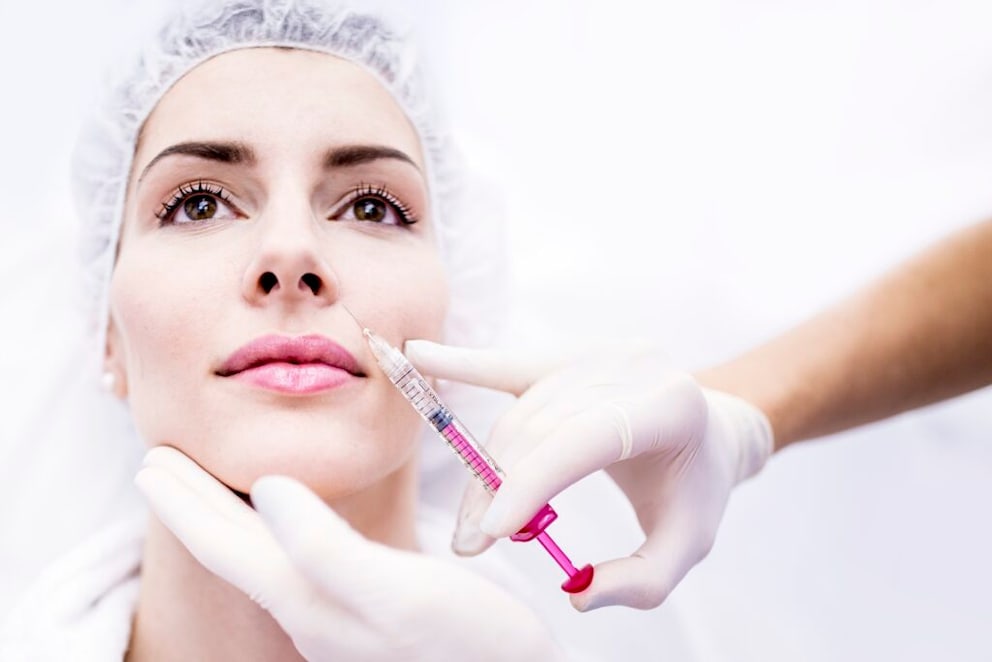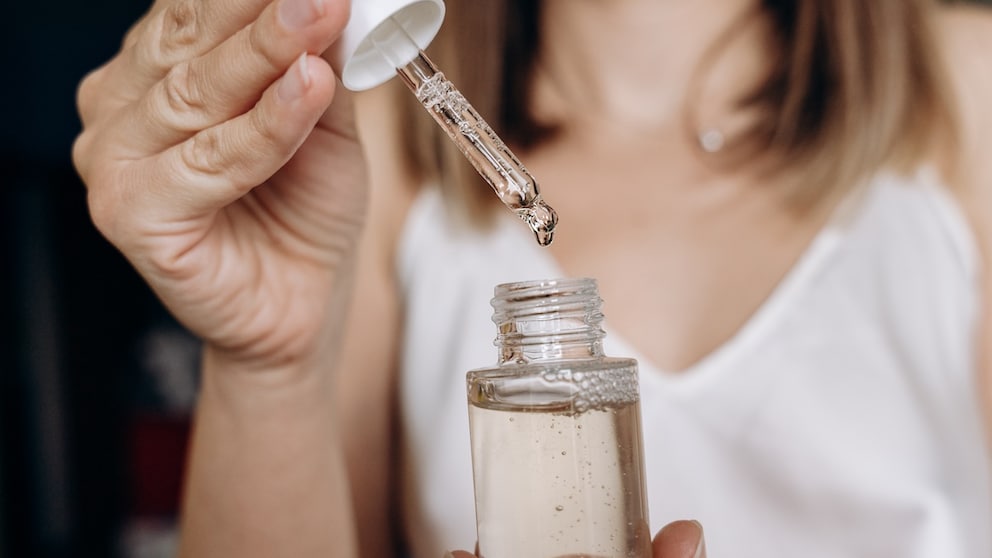April 22, 2025, 12:14 pm | Read time: 6 minutes
Some people use it to plump up their lips or inject it into wrinkles, others apply it to their face or swallow it as an ampoule treatment: we’re talking about hyaluronic acid. STYLEBOOK explains what this supposed beauty miracle cure can really do.
A firm face and still be able to frown? After Botox treatment—the number one wrinkle killer for years—this is only possible to a limited extent. That’s why the cosmetics industry is now increasingly turning to hyaluronic acid. However, the “miracle cure” is not only supposed to provide smoother skin, it can do even more. STYLEBOOK spoke to a dermatologist about the use of hyaluronic acid against wrinkles.
Overview
What Is Hyaluronic Acid?
Hyaluronic acid, also known simply as hyaluron, is actually a fluid produced naturally in the body. Munich dermatologist Dr. Miriam Rehbein explains: “Hyaluronic acid is a main component of human connective tissue. It can bind large amounts of water, which is why it plays a decisive role in the moisture content of our skin.” With age, however, the production of the body’s own hyaluronic acid decreases—the skin loses its firmness and wrinkles become more visible. If you want to help here, you can use hyaluronic acid from the laboratory.
Hyaluronic acid is either obtained from cockscombs or biotechnologically extracted from streptococcus cultures. Back in the late 1990s, researchers developed a process that enables the production of hyaluronic acid through bacterial fermentation. This biotechnologically produced hyaluronic acid is significantly purer than animal-based hyaluronic acid and therefore poses less of a health risk. Nevertheless, animal sources (e.g., from slaughterhouse waste) remain an important resource for obtaining hyaluronic acid even today due to the higher costs of the fermented variant. If you do not want this for ecological and/or ethical reasons, please pay attention to the “vegan” seal.
Attributed Effect of Hyaluronic Acid
Thanks to its water-binding properties, hyaluronic acid plumps up the cells, as Dr. Rehbein confirms. “Visual results are particularly noticeable in the connective tissue after treatment with hyaluronic acid. Among other things, the skin on the face appears plumper and smaller wrinkles are smoothed out thanks to the plumping effect,” says the dermatologist. Similar to the body’s own hyaluronic acid, the artificial version is also broken down by the body after some time. “Depending on the area of the body and the amount of hyaluronic acid, this can take six to 18 months,” says the expert.
Areas of Application for Hyaluronic Acid
It is no longer a secret that hyaluronic acid counteracts the signs of skin ageing. Hollywood stars also swear by the immediate effect of injected hyaluronic acid. However, creams and oral capsules can also help to boost the body’s own hyaluronic acid production.
Hyaluronic Acid in Creams
Hyaluronic acid is an integral part of eye creams, as the fine lines around the eyes are often caused by a lack of moisture. The addition binds more water to the affected area, making the skin appear firmer. Serums or masks also provide an immediate effect and are available in drugstores for relatively little money. There are no differences in quality, although the concentration in over-the-counter products is significantly lower than in a hyaluronic acid injection.
Hyaluronic Acid as a Serum
Let’s talk about the test results from “Ökotest.” Of 25 hyaluronic serums tested, 13 claim to be anti-aging on the packaging. The testers therefore requested evidence. The result: only four manufacturers were able to provide comprehensive, product-related studies.
But there is also a catch here: even these studies do not prove any significant advantage of the tested hyaluronic serums compared to conventional, often significantly cheaper products in the opinion of “Ökotest.” Even simple care creams that moisturize the skin show a short-term effect. Furthermore, they did not accept evidence that only describes the effect of the hyaluronic acid itself, as it only makes up a small proportion of the finished cosmetic product. The effect must be proven for the entire formulation. Unfortunately, this was not the case for any product!
Hyaluronic Acid as a Dietary Supplement
Hyaluronic acid is also available as a capsule for swallowing, the effect of which is more holistic. Not only the skin and connective tissue are supplied with the substance, but also the joints. According to the manufacturers, the preparation should be taken for at least three months at around 200 to 500 mg per day until the first results can be seen in the appearance of the skin. Dr. Rehbein, however, is rather sceptical about the effectiveness of dietary supplements: as hyaluronic acid is a polysaccharide (multiple sugar), it is used and broken down by the body just like a sugar molecule.
Getting Hyaluronic Acid Injections

The gel-like texture of hyaluronic acid is ideal for sculpting the skin. Lip injections are particularly popular—depending on requirements, between 0.5 and 2 milliliters of hyaluronic acid are used to enlarge the lips. The nasolabial fold and wrinkles around the eyes can also be injected to make them appear less deep, as Dr. Rehbein explains. In contrast to creams, pure hyaluronic acid is used for injections, so the effect is not only immediately visible, but also more long-lasting. A treatment with hyaluronic acid costs—depending on the amount used—starting at 300 euros, as the specialist explains.
Possible Risks of Hyaluronic Acid Injections
As hyaluronic acid injections are an invasive procedure, side effects can theoretically always occur. Bruising or slight swelling are possible, but these will quickly disappear. An allergic reaction cannot be ruled out either, although according to the dermatologist, it almost never occurs. In any case, it is important that the treatment is carried out by an experienced and reputable cosmetic surgeon who weighs up the risks beforehand and explains them.
Expert Assessment
Hyaluronic acid is a very popular cosmetic ingredient in skin care. However, it is questionable whether it is a true anti-aging miracle when applied superficially. Dr. Rehbein also explains that the hyaluronic acid contained in creams cannot really penetrate the skin, as the molecule is too large for the pores. “Hyaluronic creams do have a plumping effect on the skin, but this is rather short-lived,” summarizes the specialist. Nevertheless, hyaluronic acid in creams and serums is at least not harmful. It still provides the skin with moisture and can help to improve the skin’s structure.

Hyaluronic Acid Against Wrinkles? Application, Effect, Risks

Beautiful Through Capsules, Beauty Gums, and More: What Dietary Supplements Really Deliver

Saving Shrunken Clothing Quickly and Easily
What Consumer Protection Says
When using hyaluronic acid, the consumer advice center differentiates between the various ways in which it can be taken. If the active ingredient is regarded as a dietary supplement, it has not been proven that it contributes to maintaining skin moisture. Advertising promises to this effect are therefore prohibited for food supplements. Stiftung Warentest also believes that it is better not to expect too much from hyaluronic acid in creams. It cannot work as well on the surface as it can as an injection.

